New York Governor Kathy Hochul on Friday declared a emergency in the state over the discovery of polio virus in four counties.
A person was found to be infected with polio in New York state's Rockland County in July, following which the authorities began wastewater surveillance. The case reported in July was the first in the United States in around a decade.
Gov. Hochul has urged people to get vaccinated agains polio if they are not and the authorities have also suggested boosters for people who are likely to come in contact with virus, such as healthcare professionals.
Here we explain what's polio virus, what authorities have found in New York, and why the outbreak is concerning. This is the third discovery of polio virus in the developed world after London in the United Kingdom and Jerusalem in Israel.
What's polio virus, how it spreads?
Polio disease is caused by polio virus, which is short for poliomyelitis.
Polio spreads through direct contact with contaminated source, such as by coming into contact with faeces of an infected person or by inhaling droplets of an infected person released during coughing or sneezing.
"People living in areas with limited access to running water or flush toilets often contract polio from drinking water contaminated by infected human waste," says Healthline.
Though all age-groups can be infected, children under five are particularly vulnerable to the virus. Healthline further adds that pregnant women, people with weakened immune systems, such as those who are HIV-positive, are most vulnerable.
There is no cure for polio but it can be prevented by vaccines which are highly effective. There are two types of vaccines, one which is taken as an injection and second that are taken orally as drops.
Polio can be both symptomatic and asymptomatic. In rare cases, it can cause paralysis.
Healthline says that up yo 95-99 per cent people are asymptomatic but they can still spread the virus. Symptomatic polio is of two types.
1. Non-paralytic polio
Healthline lists the following signs and symptoms:
- fever
- sore throat
- headache
- vomiting
- fatigue
- meningitis
2. Paralytic polio
Around 1 per cent of cases develop paralytic polio which can lead to paralysis in the spinal cord, brainstem, or both.
Healthline says that initial symptoms are similar to non-paralytic polio, but more severe symptoms appear after a week, including:
- loss of reflexes
- severe spasms and muscle pain
- loose and floppy limbs, sometimes on just one side of the body
- sudden paralysis, temporary or permanent
- deformed limbs, especially the hips, ankles, and feet
What are findings in New York, what are officials saying?
The US Centers for Disease Control and Prevention (CDC) analysed the wastewater samples from New York state and found poliovirus in samples from Rockland County, Orange County, Sullivan County, New York City, and Nassau County.
"The sample collected in August from Nassau County has been genetically linked to the case of paralytic polio previously identified in Rockland County, further evidence of expanding community spread," said New York Department of Health.
Authorities suspect that could be hundreds of unreported cases of polio.
"Based on evidence from earlier polio outbreaks, health officials estimate that for every one case of paralytic polio observed, there may be hundreds of other people infected," said the NY Health Department.
Authorities have urged the unvaccinated people to get vaccinated, people with incomplete schedule to complete their vaccination regime, and also suggested boosters for people who are likely to come into contact with the virus, such as healthcare workers.
The authorities have released the following guidelines for polio vaccination and boosters:
- All children should get four doses of the polio vaccine: at 6 weeks-2 months of age, at 4 months of age, at 6-18 months old, and 4-6 years old.
- People starting the polio immunisation series after 4 years of age who are unvaccinated or are unsure if they have been immunised should receive a total of three doses.
- Adults who have only had one or two doses of the polio vaccine in the past should get the remaining doses.
- Following classes of people should get polio vaccine boosters: People who will or might have close contact with a person known or suspected to be infected, healthcare/virology laboratory professionals in areas where poliovirus has been detected, and people exposed to wastewater.
The polio was eradicated from the United States in 1979. The case in July is first in over a decade. It's a "vaccine-derived" strain of virus.
Polio vaccination, eradication, and vaccine-derived strain
There are two types of polio virus vaccines: inactivated polio virus (IPV) vaccines given as an injection and oral polio vaccines (OPV) containing a live attenuated (weakened) virus.
Both of these vaccines are highly effective prevention polio infections. However, IPVs are relatively safer as they involve a dead (inactivated) virus. OPVs are widely used in lower- and middle-income countries in Asia and Africa (including India) as they are cheaper —OPV costs 12 cents a dose whereas IPV costs $2— and can requires no training to be adminstered as they are just like any other oral drops. But OPVs carry a very small risk of vaccine-derived polio, which is the one detected in New York.
When OPVs doses are administered, the weakened virus replicates in the intestines of the person for a limited time, leading to the development of immunity. However, the person would also shed this virus in faecal matter for this duration. This virus in faecal matter has the potential to spread in the community. If there is sufficient vaccination in the community, it can offer 'passive immunisation' but it can also cause infection if the community is under-immunised.
"On rare occasions, if a population is seriously under-immunized, an excreted vaccine-virus can continue to circulate for an extended period of time. The longer it is allowed to survive, the more genetic changes it undergoes. In very rare instances, the vaccine-virus can genetically change into a form that can paralyse – this is what is known as a circulating vaccine-derived poliovirus (cVDPV)," says World Health Organization (WHO).
During 2000-17, of the 10 billion OPV doses administered worldwide, 760 such infections were reported, according to WHO.
Besides this vaccine-derived polio virus strain, there are three wild polio strains: poliovirus type 1 (WPV1), wild poliovirus type 2 (WPV2) and wild poliovirus type 3 (WPV3). Two of these strains —types 2 and 3— were completely eradicated by 2019, as per WHO, which adds that type 1 strain remains in circulation only in Pakistan and Afghanistan.
What does New York emergency mean?
New York Governor Kathy Hochul on Friday declared an emergency through an executive order.
The purpose of initiating the emergency is two-fold: to boost vaccination and to collect data on vaccination and infections.
It seeks to boost vaccination by allowing non-doctors such as nurses and pharmacists to conduct vaccination. It also requires them to submit such data to state.
The New York Department of Health said, "The Executive Order immediately expands the network of polio vaccine administrators with the addition of emergency medical services workers, midwives, and pharmacists and authorises physicians and certified nurse practitioners to issue non-patient specific standing orders for polio vaccines.
"The Executive Order also requires healthcare providers to send polio immunization data to the New York State Department of Health (NYSDOH)...enabling NYSDOH and local health departments to focus vaccination activities where they are needed most and have yet another datapoint to understand the level of protection against polio in communities."
Significance of polio findings in New York
While over 90 per cent of American children are vaccinated against polio, there are pockets in the country with low vaccination. Rockland County has 60 per cent vaccination rate of children up to 2 years of age. Vox further noted, "Almost 14 per cent of New Yorkers between 6 months and 5 years old are unvaccinated, putting them at additional risk."
The polio in New York has been discovered in the midst of ongoing Covid-19 pandemic and Monkeypox crisis, both of which are of grave concern in the United States. Therefore, the emergence of polio virus puts the already streatched-out health infrastructure under further strain.
A wider outbreak, however, is unlikely because the overall vaccination rate is high in the United States.
"I do not think there will be an outbreak of paralytic polio (symptomatic disease) with such high rates of vaccination in the United States if we can catch up. I think our efforts should focus on vaccinating those who have never had a primary polio vaccine series such as children who missed their childhood vaccines during COVID as well as those (like this young man) who are adults and not yet vaccinated," said University of California Prof. Dr. Monica Gandhi to Healthline.
However, the emergence of polio virus in New York and in London in the United Kingdom and in Jerusalem in Israel suggests that while wider outbreaks like in the pre-vaccination days remain highly unlikely, it's still possible for the virus to circulate in lesser-vaccinated communities with the capability to infect hundreds, as is expected to be the case in New York.
The UK has started giving polio virus vaccine boosters to children aged 1-9 years in London as a precaution.


























